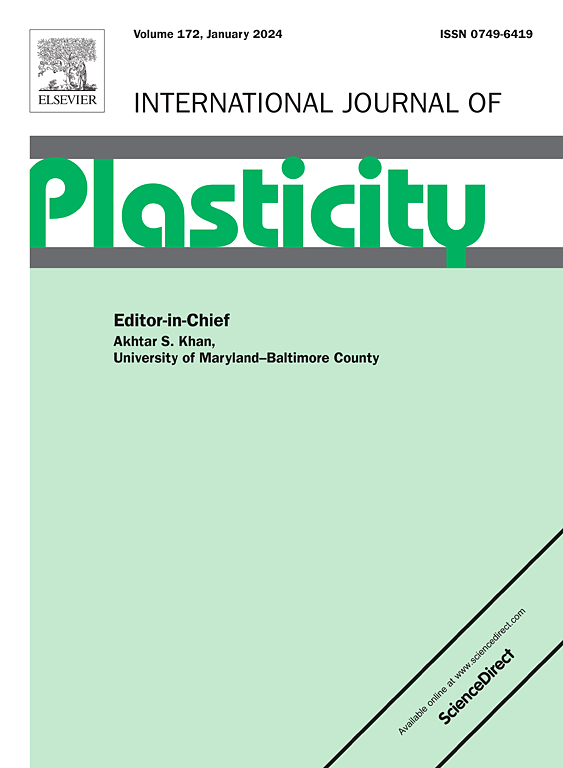A Physically Grounded Model for Size Effects in the Initial Yielding of Metallic Materials with Deformation Heterogeneity
IF 9.4
1区 材料科学
Q1 ENGINEERING, MECHANICAL
引用次数: 0
Abstract
The size effect in the initial yielding of metallic materials with deformation heterogeneity has garnered significant attention. However, the underlying physics of this effect remains unclear, and physically grounded models that quantify the relationship between microstructure and mechanical properties are still lacking. Here, we revisit both stress and strain gradient plasticity models, focusing particularly on the stress gradient model due to its physical material length scale and straightforward numerical implementation. By deriving yield stress models based on single-ended dislocation pileup, we identify a critical issue in stress gradient models: the assumption of dislocation pile-up configurations significantly affects yield stress predictions. To elucidate the dislocation mechanisms driving the size-dependent yielding behavior, we investigate two benchmark cases in gradient theories: homogeneous materials undergoing nonuniform deformation and heterostructured materials undergoing uniform deformation, utilizing nonlocal crystal plasticity and discrete dislocation dynamics simulations, respectively. The results not only clarify the issue raised in stress gradient theory, but also suggest the mechanism that pileup-induced stress plays a dominant role in governing the size effect during initial yielding for both homogeneous materials and heterostructured materials. These insights lead to the development of a new physically grounded model based on pileup-induced internal stress, i.e., back stress, which quantitatively predicts the size effect in the initial yielding of heterostructured material under tension and homogeneous material under torsion. This work clarifies the dislocation mechanisms governing extra strengthening in metallic materials with deformation heterogeneity and introduces a physically-based model quantitatively correlating the microstructures with the mechanical properties of heterostructured materials.


具有变形非均匀性的金属材料初始屈服尺寸效应的物理基础模型
具有变形异质性的金属材料在初始屈服过程中的尺寸效应引起了广泛关注。然而,这种效应的基本物理原理仍不清楚,也缺乏量化微观结构与机械性能之间关系的物理基础模型。在此,我们重新审视了应力梯度和应变梯度塑性模型,尤其侧重于应力梯度模型,因为它具有物理材料长度尺度和直接的数值实现。通过推导基于单端位错堆积的屈服应力模型,我们发现了应力梯度模型中的一个关键问题:位错堆积构型假设对屈服应力预测有很大影响。为了阐明驱动与尺寸有关的屈服行为的位错机制,我们分别利用非局部晶体塑性和离散位错动力学模拟,研究了梯度理论中的两个基准案例:发生非均匀变形的均质材料和发生均匀变形的异质结构材料。结果不仅澄清了应力梯度理论中提出的问题,还提出了堆积诱导应力在均质材料和异质结构材料初始屈服过程中的尺寸效应中起主导作用的机制。这些见解促成了基于堆积诱导内应力(即背应力)的新物理基础模型的发展,该模型可定量预测拉伸条件下异质结构材料和扭转条件下均质材料初始屈服过程中的尺寸效应。这项研究阐明了支配具有变形异质性的金属材料额外强化的位错机制,并引入了一个基于物理的模型,定量地将异质结构材料的微观结构与力学性能联系起来。
本文章由计算机程序翻译,如有差异,请以英文原文为准。
求助全文
约1分钟内获得全文
求助全文
来源期刊

International Journal of Plasticity
工程技术-材料科学:综合
CiteScore
15.30
自引率
26.50%
发文量
256
审稿时长
46 days
期刊介绍:
International Journal of Plasticity aims to present original research encompassing all facets of plastic deformation, damage, and fracture behavior in both isotropic and anisotropic solids. This includes exploring the thermodynamics of plasticity and fracture, continuum theory, and macroscopic as well as microscopic phenomena.
Topics of interest span the plastic behavior of single crystals and polycrystalline metals, ceramics, rocks, soils, composites, nanocrystalline and microelectronics materials, shape memory alloys, ferroelectric ceramics, thin films, and polymers. Additionally, the journal covers plasticity aspects of failure and fracture mechanics. Contributions involving significant experimental, numerical, or theoretical advancements that enhance the understanding of the plastic behavior of solids are particularly valued. Papers addressing the modeling of finite nonlinear elastic deformation, bearing similarities to the modeling of plastic deformation, are also welcomed.
 求助内容:
求助内容: 应助结果提醒方式:
应助结果提醒方式:


